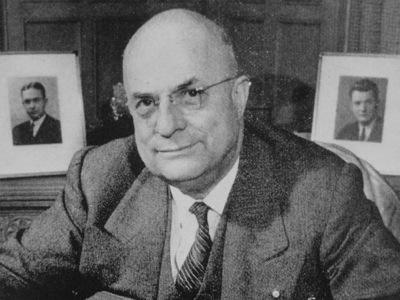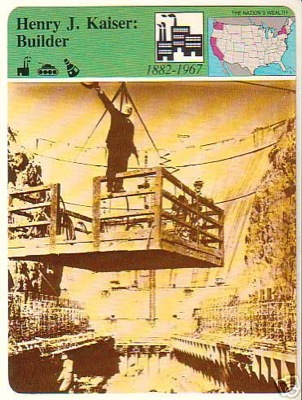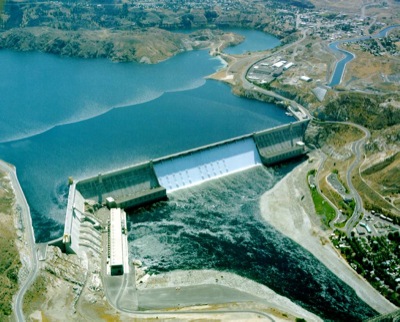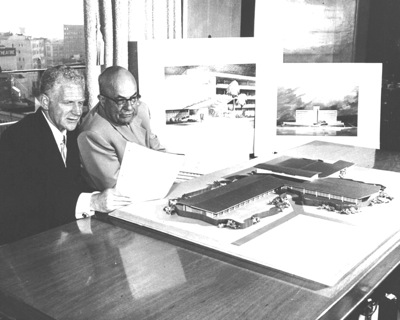In the Antiplanner’s not-so-humble opinion, Fortune magazine made a mistake in declaring Henry Ford to be the businessman of the twentieth century. True, Henry Ford made a lot of cars. But Henry Kaiser built roads, dams, houses, hotels, ships, and planes. He made cement, steel, magnesium, aluminum, and a variety of other chemicals and building materials. He funded and built the first and still the greatest health maintenance organization in the world.

Plus, he also made cars. Chances are, you see a car made by one of his former companies just about every time you go out on the street.
To show that Kaiser was the epitome of an entrepreneur, I’ll present Kaiser’s story in four segments: through 1939, the war years, the post-war years, and Kaiser’s Hawaii ventures, with a wrap-up segment about his legacy.
Born in upstate New York in 1882, Kaiser quit school at age 13 to work in a dry goods store. By the time he was 17, he was working as a traveling salesman. Among the things he sold were photographic supplies and among the places he traveled to was Lake Placid, NY.
He liked Lake Placid so much that, when he was 20, he approached a Lake Placid photographer and offered to work for him for free. The catch was that, if Kaiser could double the man’s business, they would share the profits 50-50. Within a year, Kaiser had tripled the business, and the photographer ended up selling it to him.
For a few years, Kaiser was content to run a summer photo business in Lake Placid and a winter photo business in Florida. He apparently was something of a playboy, enjoying swimming, boating, and the company of pretty girls.
When he was 24, he was immediately smitten when a 20-year-old woman named Bess Fosburgh entered his studio for a portrait. Within a few weeks the two were engaged. Bess’ father, however, disapproved of Kaiser’s peripatetic lifestyle, and made the strange demands that Kaiser move west to establish himself in a new business earning at least $125 a month and that he build a house.
So Kaiser traveled west and ended up in Spokane, where he went back to work as a salesman in a hardware store. Many of his customers were building contractors, and he quickly learned their business and soon went to work in that field. In less than a year he earned enough to build a large house, so he returned to the East Coast and married Bess.
Back in Spokane, Kaiser held a series of jobs until 1912, when the company he worked for suddenly went out of business even though it had a contract to pave streets in Victoria, BC. So he started his own company that finished the Victoria paving and worked on paving contracts all over the Northwest.
Kaiser gained a reputation for hard work, audacity, and finishing his jobs well before the deadlines. His audacity showed one day when his foreman told him that they didn’t have enough money to make payroll. “How much do we have?” he asked. “$600.” So he took the $600, went to a car dealer and made a down payment on a brand new Lincoln. He then parked the Lincoln outside the office window of a bank president and entered the bank to ask for a $10,000 loan. The banker eyed the car and gave him the money. “Now we can make payroll,” he told his foreman.
In 1920, one of his employees happened to be in Redding, CA, and heard that the state of California was opening bids for paving contracts. Deciding to place a bid, Kaiser got on the fastest train south only to find that the train didn’t stop at Redding. So he waited for the train to slow down, opened the door and jumped off. He ruined his suit, but got the job.

In 1979, a company called Panarizon issued a Story of America series of cards. This card, available on ebay, features Henry Kaiser grandstanding in front of Hoover Dam.
Moving to Oakland, Kaiser built roads and small dams in the California mountains. In 1927, he won a contract to build 200 miles of road in Cuba, which he fulfilled a year ahead of time and which earned him $20 million. However, he also learned that officials in foreign countries often expected bribes. Kaiser absolutely refused to pay bribes and for many years after avoided foreign projects because he did not want to deal with such corruption.
Kaiser’s work earned the respect of many of his competitors, including Warren Bechtel, founder of what is now the largest construction company in the world. In 1931, Kaiser, Bechtel, and several other companies joined to form the “Six Companies” that won the contract to build Hoover Dam.
Kaiser’s crew supplied the sand and gravel, and Kaiser himself chaired the Six Companies’ executive committee “in recognition of his ability to get people to work together.” He also served as the Companies’ liaison to the Washington, DC, bureaucracy. During the 1930s, the Six Companies built Hoover, Bonneville, and Grand Coulee dams, three of the largest construction projects in the history of the world. They also worked on many other projects including the San Francisco Bay Bridge and the Caldecott Tunnels between Oakland and Contra Costa County.

Grand Coulee Dam, one of the largest dams in the world.
As an employer, even when he was a contractor, Kaiser tried to treat his employees as partners. So he was intrigued in 1938 when a young medical doctor named Sidney Garfield proposed a new system of preventative health care. Kaiser and the Six Companies were building the massive Grand Coulee Dam, which required thousands of workers to live in a place with virtually no medical facilities.
On previous construction projects, Garfield had learned that a system of prepaid medical care would encourage patients to visit their doctors before their sicknesses became serious. The result was that they could often be treated at a much lower cost than if they waited until the disease was more debilitating. Garfield proposed the system to Kaiser. While Garfield only saw the system as a way of providing care to workers on short-term construction projects, Kaiser immediately saw that it would revolutionize health care in America.

Sidney Garfield and Henry Kaiser plan some of the Kaiser Permanente clinics and hospitals.
From then on, most of Kaiser’s workers and their families were eligible for this care. While Garfield had invented the HMO, it was Kaiser who made it possible and who created a Kaiser network of hospitals and clinics.
In 1938, the Six Companies were disappointed to lose the bid for building Shasta Dam to another group of contractors. Kaiser, however, quickly won the subcontract to provide sand, gravel, and concrete to the dam builders.
Kaiser happened to own a gravel mine about 10 miles from the site of Shasta Dam. When the Southern Pacific Railroad quoted him a price of 27 cents a ton for moving gravel to the dam, he build a 10-mile conveyer belt that moved the gravel for just 18 cents a ton.
Kaiser also happened to own a limestone quarry on Permanente Creek near San Jose. At the time, a California cement cartel kept prices high. A firm believer in the benefits of competition, Kaiser broke the cartel. He had a cement kiln in operation well before the Shasta Dam needed it, so Kaiser started selling cement to contractors throughout California.
Kaiser later said that Shasta Dam “was the best contract we ever lost.” Up to then, he had been a contractor, with just a handful of permanent employees. Getting into the cement business, however, turned him into an industrialist, with first hundreds, later thousands, and — during the war — hundreds of thousands of full-time employees.
One of the major buyers of Kaiser cement was the U.S. Navy. Since it had the port at Pearl Harbor, Kaiser began shipping bulk cement to Hawaii. Thus, he had a large supply on hand when it was needed to repair airfields after the Japanese attack in 1941. Soon, Permanente was supplying cement to army and navy bases throughout the entire south Pacific.
Though profitable, cement turned out to be only a minor part of Kaiser’s contribution to the war. The war changed Kaiser’s public image from a California contractor into an American hero whose international renown was almost as great as Henry Ford’s.
Next: The War Years.








I wonder how many planning zealots here ever built a company that employed people who actually built or manufactured something, instead of sitting in an ivory tower and planning other, unsuspecting, people’s lives.
Thanks
JK
http://www.youtube.com/watch?v=VXcbyrw9PNA
Kaiser has made some interesting ads too.
WOW. Highwayman, that’s amazing to see a major health company showing child endangerment.
Of course I am referring to towing a child on a vehicle that has a death rate around ten times that of a private car. (A bike.)
Should be a crime.
(A note for the mathematically illiterate: rate, in this case, means deaths per passenger mile.)
Thanks
JK
Thanks JK, for showing us that libertarian paradox.
“(A note for the mathematically illiterate: rate, in this case, means deaths per passenger mile.)”
I think it is high time to outlaw everything that kills people yet does not transport them at all 😉 Also, biking does not kill, getting hit by cars on a bike does.
JK wrote:
“WOW. Highwayman, that’s amazing to see a major health company showing child endangerment.
Of course I am referring to towing a child on a vehicle that has a death rate around ten times that of a private car. (A bike.)
Should be a crime.”
I’m amazed.
On just about every topic JK is going to be out there defending freedom of choice (including the choice of living in the suburbs).
When it comes to transport, though, you shouldn’t have a bicycle, apparently. So much for choice. What’s wrong with getting a bit tougher on car drivers who can’t take driving seriously?
Anyway, back to the topic of this thread. Antiplanner wrote:
“In the Antiplanner’s not-so-humble opinion, Fortune magazine made a mistake in declaring Henry Ford to be the businessman of the twentieth century. True, Henry Ford made a lot of cars. But Henry Kaiser built roads, dams, houses, hotels, ships, and planes. He made cement, steel, magnesium, aluminum, and a variety of other chemicals and building materials. He funded and built the first and still the greatest health maintenance organization in the world.”
My choice would be Mr. Taylor. His process of downskilling work in factories, by breaking down each task into a series of simple movements, achievable by mechanisation, was what reduced the price of the Model T Ford down to what ordinary people could afford – the price halved. It wasn’t Henry Ford who invented assembly line working – many of his competitors were also doing assembly line working, and the Royal Navy had been doing assembly line manufacturing 100 years before Henry Ford ‘invented’ it.
Mr. Taylor, of course, was very controversial. He seriously hacked off skilled craftsmen, for obvious reasons. Henry Ford adopted Taylor’s process, and suffered from massive turnover of staff as a result. Ford’s solution to the crisis, to increase pay from $2/day to $5/day, astounded his contemporaries.
The Model T Ford has been and gone, and yet Taylor’s process is used today more than ever.
{JK wrote:
“WOW. Highwayman, that’s amazing to see a major health company showing child endangerment.
Of course I am referring to towing a child on a vehicle that has a death rate around ten times that of a private car. (A bike.)
Should be a crime.â€Â
I’m amazed.
On just about every topic JK is going to be out there defending freedom of choice (including the choice of living in the suburbs).}
This is what’s called ading insult to injury.
Look, libertarians just don’t give a damn, so long as they can grift the system!
Francis King,
Frederick Winslow Taylor was a fascinating person, but he was not an entrepreneur. He was a management consultant, like Peter Drucker or McKinsey.
Pingback: » The Antiplanner
Does anyone have a comment on this:
“I wonder how many planning zealots here ever built a company that employed people who actually built or manufactured something, instead of sitting in an ivory tower and planning other, unsuspecting, people’s lives.
JK: Guess not many have actually done something useful.
Thanks JK
Though what have you libertarian zealots done other than raise costs?
highwayman said: Though what have you libertarian zealots done other than raise costs?
JK: How has freedom and equal rights raised costs? I hope you are not going to bring up recent criminal activity in the financial markets as a Libertarian thing – turns out its a Democrat thing with some Republican co-conspiracy. Libertarians believe in the government regulating to the point of ensuring a level playing field and no fraud. We do not believe in regulating to the point of creating or protecting monopolies. You have a problem with this?
BTW, its the planners that raise costs by forcing expensive solutions to non problems on unsuspecting people:
* Light rail costs more than private cars, but the planners hide its cost.
* High density costs more than low density, but the planners lie about its cost.
* Trams cost more than buses, but planners lie about its cost.
Thanks
JK
Deaths per passenger mile is an inappropriate measure for comparing different modes. VMT and PMT confuse the length of the each trip with the utility of each trip. Thus a more appropriate measure is deaths per million trips.
To prove I’m not biased, here are the basic findings of the TRB’s Special Report 269 – The Relative Risks of School Travel.
Each line is: mode, injuries per 100m trips, per 100m miles, deaths per 100m trips, per 100m miles.
School Bus, 100,20, 0.3, 0.1
Other Bus, 120, 20, 0.1, 0.1
Auto (teen driver), 2300, 430, 13.2, 2.4
Auto (adult driver), 490, 90, 1.6, 0.3
Bicycle, 1610, 2050, 9.6, 12.2
Walk, 310, 130, 4.6, 8.7
Total, 650, 130, 3.5, 0.7
Full report PDF download at the bottom of this page:
http://www.trb.org/news/blurb_detail.asp?id=673
Well, then, we should all be riding buses, shouldn’t we?
Now, back to Randal’s main point: Taylor was obviously a great theorist, but Ford put the theory into practice, hence his fame. He also demonstrated that if one is going to take the skill and craftsmanship out of work, then something else needs to rise to compensate for the loss, a point that apparently shocked his rivals. There remains an imperfect understanding at best of the value of labor as part of the total enterprise among finance types, and as long as that is the case, you will have leftists.
Kaiser deserves the praise Randal gave him in part for understanding the value of his workers. That understanding need not come in the form of monetary compensation, BTW: it can come in the form of treating them as partners in the enterprise, which is something that I understand Kaiser did well. A widely respected management theorist of our time, W. Edwards Deming, made his fame by stating the obvious: If you want to figure out how to perform a task better, the best people to ask are those who already do it. That too is a form of treating workers as partners in the enterprise.
Commenting on my own point by way of an anecdote:
During the dispute that led up to the Major League Baseball lockout a few seasons ago, one observer noted that the problem was that, while the owners had the money, the players had the talent and skills, and “no one pays to watch the money.”
JK wrote:
“BTW, its the planners that raise costs by forcing expensive solutions to non problems on unsuspecting people:
* Light rail costs more than private cars, but the planners hide its cost.”
Auto costs are also hidden through income & property taxes.
“* High density costs more than low density, but the planners lie about its cost.”
I live in a house my self, though if some one wants to live in a condo. That should be up to them to decide.
“* Trams cost more than buses, but planners lie about its cost.”
Depending on what you order, the costs can be a dead heat.